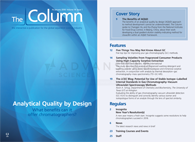New Year’s Resolution(s)
A new year means a fresh start. Incognito suggests some resolutions to help chromatographers succeed in 2018.
Photo Credit: Milleflore Images/ThinkStock Source

A new year means a fresh start. Incognito suggests some resolutions to help chromatographers succeed in 2018.
As I said in 2011 when I wrote the first New Year’s Resolution(s) piece (1), please forgive the pun!
In that first piece, I described several of my own resolutions for the coming year, including improving my preparation for meetings and conferences, investigating new stationary phases, using digital literature more effectively, and investigating the use of quality by design approaches to method validation. Some of these were achieved and, like many New Year’s resolutions, some fell by the wayside. However, the mere act of starting a new year by drawing up a list of what we might want to improve allows us to reflect on what is good and what is not so good about our science and our working lives in the laboratory. It’s an ideal time of year to do this, when the pressures of work are perhaps less onerous and we have the past year as a neat “unit” of time on which to focus our recollections.
Of course, the most difficult part of the reflective process is getting started with ideas on what we might like or need to improve. This time around I’d like to make some suggestions on areas of concern or opportunities for improvement that most often crop up when I’m working with external clients, in the hope that this inspires you to recognize these issues in your own workplace and act as an accelerant for your own resolutions.
One final tip before I get going on the list: Don’t restrict your ideas because you believe things cannot be changed or are ”above your pay grade”-this will demotivate you. Instead, look to include some changes that are “blue sky” or seemingly unachievable and, if nothing else, the mere act of contemplating these goals may begin the process of making them real.
Know Your Analyte Structure: I’ve written on this subject previously (2), but there are many folks who undertake analyses much like following a recipe, never knowing the chemical structure of the analytes they are separating. I can see that this is tempting where methods are written in prescriptive SOPs, and instrument acquisition and data analysis methods are preâprogrammed into computer data systems. Whilst things are going well this may not be an issue, but if problems with the separation occur, then knowing the chemistry of the analyte is a big advantage. For those of you who develop methods, I would propose that it’s not possible to develop good methods without considering the analyte chemistry. Make it your aim in the new year to find out more about the chemistry of your analytes; you will be amazed how quickly your insight and understanding of chromatography improves.
Know Your Analyte Physicochemical Properties: Properties such as Log P, Log D, pKa, boiling point, and vapour pressure can be vital to chromatographic behaviour of analytes. Knowing this data will help you to better understand retention, selectivity, and robustness of methods and will again assist with developing and troubleshooting methods. Undertaking a desktop evaluation of your analytes prior to method development will without doubt lead to a more efficient development process. For those of you working with analytes whose structures are in the public domain, websites such as ChemSpider, Chemicalize, and PubChem are great resources and for those whose analytes are proprietary, there are various commercial programs available for parameter estimation. A great free resource is ChemAxon MarvinSketch, which has a fairly reliable plug-in for pKa and LogP estimation (https://www.chemaxon.com/products/marvin ) and allows structures to be drawn and properties estimated.
Redevelop an Old Method: If you are using a 15- or 25-cm high performance liquid chromatography (HPLC) column with 5-mm particles, there may be better technology out there to save you time and improve your separations. If you use triethylamine or dibutylamine in your mobile phase, it may be time for a rethink. If you are using packed gas chromatography (GC) columns or if you are regularly undertaking liquid–liquid extractions, then newer technologies may have major benefits in terms of separation speed and quality. Seek advice from your column or instrument vendors to explore how methods may be improved, bearing in mind that changes to regulated methods are restricted and reâvalidation will be necessary under certain circumstances. Those following pharmacopeial methods may have some scope for change, but advice should be sought on the scope of allowable changes. Even if you consider that your capacity to change methods is limited, assess what is possible and then weigh this up against the time, effort, and cost to change.
Improve Your Knowledge of Stationary Phases: We all have our favourite HPLC and GC phases and manufacturers, but don’t restrict yourself to a narrow universe of selectivity. Take some time this year to learn about different types of phase and understand the chemistry of both the bonded phase and the underlying support material. Aim to better understand what drives retention and selectivity and why more esoteric aspects such as deactivation and bonding chemistry might affect the column properties. Many manufacturers produce C18 HPLC columns or 5% phenylmethyl polysiloxane GC columns, but how do they differ? Which is the most “extreme” pentafluorophenyl (PFP) stationary phase? Who has the most inert GC phase for your application? Which types of application are polar embedded stationary phases most suitable for? These are the types of questions that you need to be asking to push your understanding of stationary phases and improve your ability to make good column choices for method development or understand why your separation is going wrong.
Improve Your Understanding of Instrument Acquisition and Data Analysis Parameters: Print out the whole method from your data system, including the more “esoteric” parameters not usually considered during routine method setup. Whilst some method parameters are less critical than others, this does not mean that they are not important and I often see “drift” in methods, where old methods are used as “templates” for new ones and these “secondary” parameters are not considered. This is a dangerous approach because these variables can be application specific, or at least application sensitive. The more you learn about and understand secondary instrument variables, the more insight you will have when optimizing or fixing your chromatography.
Improve Your Preventative Maintenance Regime: Prevention is always better than cure, yet there are many laboratories where I see even the most basic preventative measures being ignored or undertaken too infrequently. If your work involves any element of preventative maintenance-from monitoring the status of gas filters in GC to calibrating an ultraviolet (UV) detector-make a promise to yourself that you will be as diligent as possible to keep with the programme. If you have regular instrument breakdowns, ask yourself why this might be and if there is anything that can be done to improve the preventative maintenance schedule that you are following. Your instrument manufacturers will be pleased to supply you with a maintenance schedule if you are not sure what is required.
Learn How to Properly Tune Your LC–MS or GC–MS: The auto-tune routines built in to any mass spectrometric (MS) detector are there to achieve a “reasonable” performance from the instrument. However, by learning a little more about how the ion source and mass filters work, then it is possible to tune them to give a more optimized response for the analytes with which you work. Don’t be worried that the element of consistency will be lost from work; most instruments offer the ability to save tune “target” files to aim for the optimized output that you have achieved and which can be used by your co-workers. At the very least, in the coming year, strive to understand the various numbers generated by your auto-tune reports and gain a deeper understanding of how your MS detector works.
Improve Your Sample Preparation: I see modern sample preparation as a “race for the bottom”. That is, everyone seems to want to do as little sample preparation as possible in the interests of throughput. I believe in many cases this can be false economy and that with some diligence in this area we can develop methods more easily and will suffer less failed batches of analyses and reduce instrument down time. Simplest is not always best, and if you have the option to employ a more selective sample preparation technique (solid-phase extraction or support assisted liquid–liquid extraction instead of diluteâand-shoot or protein precipitation for example), take some time to contemplate what life might be like with a cleaner and simpler analyte solution when you get to the chromatography step.
Undertake Some Training, But Give of Yourself: Take some personal time (if necessary) to improve your understanding of a technique or piece of instrumentation by carefully selecting some key webcasts and taking time to watch, and, crucially, to understand what is being conveyed. There are many webcasts that deliver a true learning experience and will help you to understand the science and technology behind new or even well-established techniques. Most webcasts are available on demand to suit your workload.
Learn About Newer Technologies: Obviously everyone will have a different list of possibilities for new technology, however, my own list for this year includes:
2D-HPLC-especially for complex mixtures containing analytes with widely varying Log P values;
Ion Mobility Spectrometry-with respect to the separation of analytes where isobaric interferences are an issue;
Atmospheric Ionization Techniques and New Modalities for MS detectors-I’m interested to see what techniques such as desorption electrospray ionization (DESI), resin-embedded multicycle imaging (REMI), and selected ion flow tube (SIFT) technologies can do for our work.
In conclusion to this long list, I’d suggest that if you see an opportunity for personal or work-based improvements, communicate your thoughts upwards and explore with your management team. As the Chinese philosopher Laozi said in the Tao Te Ching, “a journey of a thousand miles begins with a single step”.
I wish you all a very successful and highly resolved 2018.
References
- Incognito, The Column 7(1), 2–5 (2011).
- Incognito, The Column 14(16), 2–5 (2017).
Contact author: Incognito
E-mail: admin@chromatographyonline.com

A Final Word from Incognito—The Past, Present, and Future of Chromatography
February 10th 2022After 14 years in print, Incognito’s last article takes a look at what has changed over a career in chromatography, but it predominantly focuses on what the future might hold in terms of theory, technology, and working practices.
Sweating the Small Stuff—Are You Sure You Are Using Your Pipette Properly?
October 7th 2021Most analytical chemists believe their pipetting technique is infallible, but few of us are actually following all of the recommendations within the relevant guidance. Incognito investigates good pipetting practice and busts some of the urban myths behind what is probably the most widely used analytical tool.

.png&w=3840&q=75)

.png&w=3840&q=75)



.png&w=3840&q=75)



.png&w=3840&q=75)






